If you’ve ever experienced back pain or discomfort, you’ll likely agree that a healthy back is easily taken for granted until, well, it no longer feels so healthy. According to the U.S. National Institute of Health, 8 in 10 Americans will experience back pain during their lifetime. Americans spend at least $50 billion annually on back pain, making it the most common cause of job-related disability and workplace absences in the country. The bad news: with statistics like these, if you’ve not already experienced back pain at some point in your life, it’s likely you will. The good news: whether you’re looking to prevent future back injury, soothe current back pain, or strengthen and maintain a healthy back and spine, yoga can help.
Yoga increases self-awareness, teaching and encouraging the exchange of bad habits such as poor posture for healthy ones. Slumping over your laptop? Yoga will remind you to sit tall and soften the shoulders. Leaning forward to send a text message? Yoga prompts you to gently stretch your hamstrings and psoas in order to lengthen the back body, perhaps standing taller with time and reversing the spinal curve.
Along with offering body awareness and postures to counter habitual movements, yoga targets specific areas of the body to stretch, condition and relieve tension. Yoga also provides a gentle yet effective option for re-entry into an exercise regimen following pain or injury, when stopping exercise altogether can be tempting and possibly result in chronic pain over time. A yoga practice for your back will often include preventative stretching of the back, abs and spine to build strength in the trunk (think core, upper legs, hips), increase stability and lighten the load carried by the spine and pelvis. A balancing practice by nature, yoga addresses both the front and back of the body to support an evenly fortified core, lengthening to counter compressed discs and curvature that often accompany a shortened front or back body and less than ideal posture.
Yoga’s benefits for the back are many, and readily available to you with just a few postures. You will enhance your strength; improve spinal alignment and ease tension throughout the body. With regular practice, you’ll provide vital support to your body so that you’re able to walk tall again, and maintain health and peace in the body that is your temple.
The Practice Cat/Cow Pose (Marjariasana/ Bitilasana)
Benefits: Provides a full spinal stretch, balances the spinepelvis alignment, offers gentle spinal warm-up and relief to back tension and stiffness.
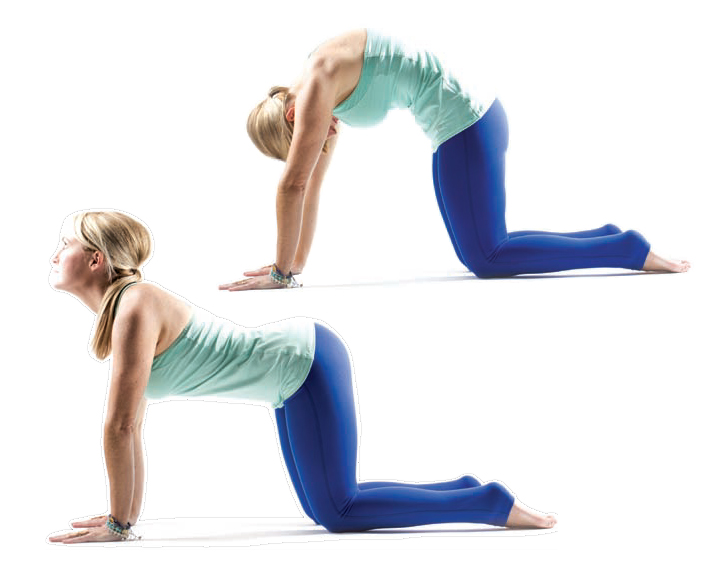
Photographer: China Fagan
Begin on hands and knees, with wrists aligned directly underneath your shoulders and knees under hips. On an inhalation, drop the belly, lifting your tailbone, chest and gaze. On an exhalation, round the back, drawing your chin to chest, navel to spine, and tailbone under as pictured. Repeat 5-10 times, synchronizing each movement to flow smoothly with your breath. With this and all of the postures below, maintain breath through the nose.
Locust Pose (Shalabhasana)
Benefits: Opens chest and shoulders, strengthens the abs, back and glutes, counters curvature of the spine and fatigue. Lie on your abdomen and rest on your forehead, extending your arms down by your sides with palms facing up. Draw your heels together on the floor. On an inhalation, lift your head, chest, arms, and legs upward, resting on your abdomen. Lengthen your legs back and up, draw your arms back by reaching actively through the fingertips and inviting the shoulder blades toward each other. Lengthen the back of the neck, taking the gaze forward or gently up. Hold for 5 breaths, lowering on an exhalation, and repeat 3-5 times.
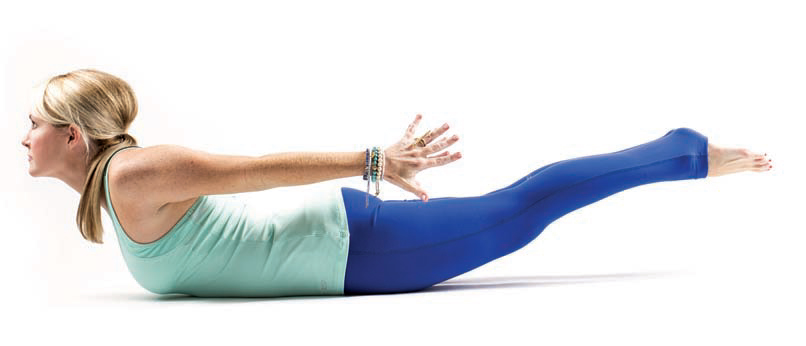
Bridge Pose (Setu Bandha Sarvangasana)
Benefits: Stretches the spine and hips, strengthens thighs and glutes, encourages chest opening.
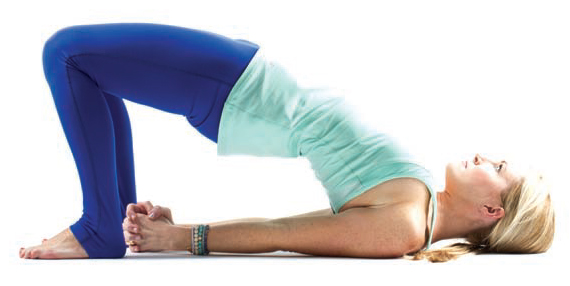
Lie on your back with knees bent and feet hip distance apart and flat on the floor near your seat. Bring knees and feet hip-distance apart, and place hands at your sides. Lift your hips as you inhale, and continue lifting up the spine until you reach the base of the
neck. Rock your shoulders and arms underneath you to interlace the hands under your back, drawing wrists toward each other. Press the arms and fist into the mat as you continue to lift your hips. Hold for 5 breaths, releasing the hands and arms from underneath you before lowering the spine down top to bottom on an exhalation, one vertebra at a time. Repeat 3-5 times.
Crescent Lunge Pose (Anjaneyasana)
Benefits: Stretches the spine, legs, groin, and hips, opens the chest and shoulders, enhances balance and stability, provides energy and reduces fatigue.
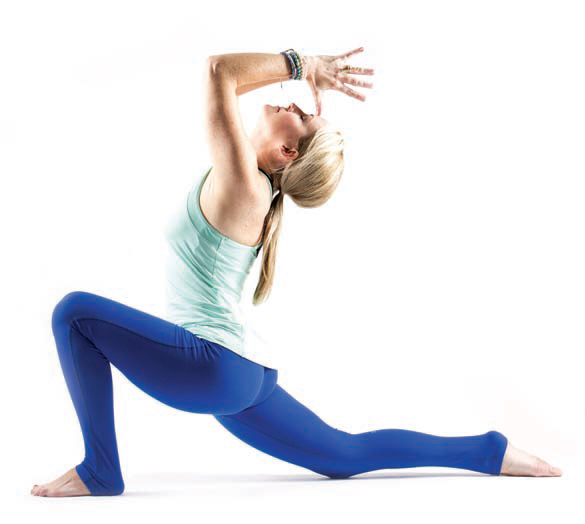
From hands and knees, step your left foot forward in between your hands, keeping the knee aligned directly above the ankle. (The knee can extend forward of the ankle if you have healthy, pain-free knees.) Slide the right knee back to find a gentle stretch in the groin and front of the right hip. Resting on the top of the right foot, sink your pelvis forward and down to deepen the lunge. Draw hands to rest on the left thigh, keeping shoulders soft. Once you feel steady, sweep the arms overhead and press palms together, creating a soft backbend as you gaze up.
Seated Spinal Twist (Ardha Matsyendrasana)
Benefits: Increases flexibility of full spine, detoxifies, enhances digestion and normal spinal rotation.
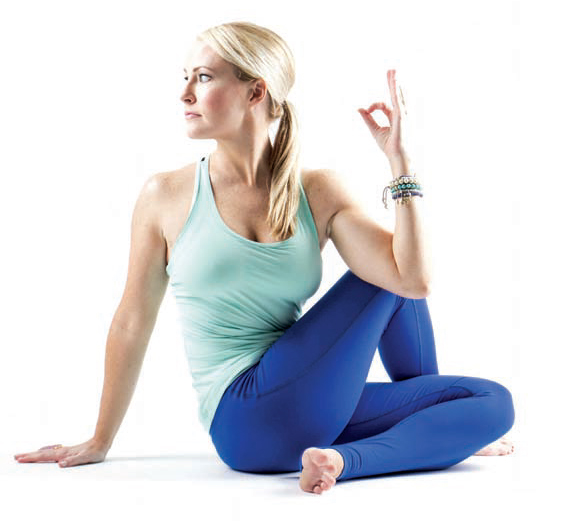
Begin seated with both legs extended in front of you. Bending the right knee, step the right foot over to the outside of the left knee. Bending the left knee, draw the left foot toward your right sitting bone and place the right hand behind you for support. Inhale and extend the left arm high alongside your ear as you lift your chest; exhale as you twist right and draw the left elbow outside of the right thigh. Hold the twist as you inhale to lengthen the spine and exhale to deepen the twist for 5 breaths. Slowly release the pose, moving through center and folding over your left side. Change sides and repeat. Please consult a physician before participating in this or any exercise regimen, and seek guidance from a certified yoga instructor before beginning a yoga practice.
 Elizabeth Rowan is a native Southerner with wanderlust. She has lived, practiced and studied yoga in the U.S., Europe and Asia. She received her teaching certificate from Anahata Yoga, Hong Kong, while studying under Yogananth Andiappan, son of Dr. Asana Andiappan of Chennai, India. She is also a certified Pranakriya prenatal yoga teacher and Radiant Child Yoga teacher. Elizabeth currently teaches both private and group vinyasa, prenatal and children’s yoga and writes about wellness, yoga and lifestyle. Elizabeth currently lives in Savannah, Georgia, and continues to search for the Sanskrit equivalent of y’all. www.havenyoga.com
Elizabeth Rowan is a native Southerner with wanderlust. She has lived, practiced and studied yoga in the U.S., Europe and Asia. She received her teaching certificate from Anahata Yoga, Hong Kong, while studying under Yogananth Andiappan, son of Dr. Asana Andiappan of Chennai, India. She is also a certified Pranakriya prenatal yoga teacher and Radiant Child Yoga teacher. Elizabeth currently teaches both private and group vinyasa, prenatal and children’s yoga and writes about wellness, yoga and lifestyle. Elizabeth currently lives in Savannah, Georgia, and continues to search for the Sanskrit equivalent of y’all. www.havenyoga.com






